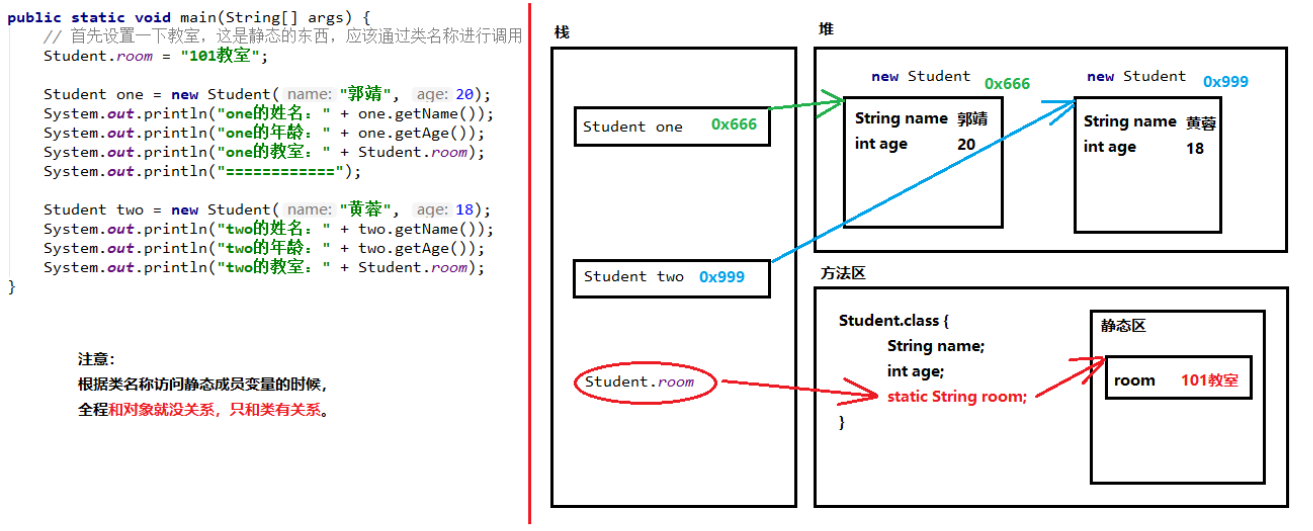- 一旦使用static修饰成员变量,那么这个变量不再属于对象自己,而是属于所在的类。多个对象共享同一份数据。
- 一旦使用static修饰成员方法,那么这就成为了静态方法。静态方法不属于对象,而是属于类的。
无论是成员变量,还是成员方法。如果没有static关键字,那么必须首先创建对象,然后通过对象才能使用它。如果有了static,都推荐使用类名称进行调用。
静态变量:类名称.静态变量
静态方法:类名称.静态方法()
使用场景:在同一类中,当某一数据被所有实例化对象共享时,可以用static修饰
注意事项:
1. 静态不能直接访问非静态。
1)static修饰的方法不能引用非static 修饰的变量
2)非static修饰的方法可以引用static 修饰的变量
原因:因为在内存当中是【先】有的静态内容,【后】有的非静态内容。
“先人不知道后人,但是后人知道先人。”
2. 静态方法当中不能用this或者super。
原因:this代表当前对象,通过谁调用的方法,谁就是当前对象。
public class Student {
private int id;
private String name;
private int age;
static String room="Class 10 room";
private String home;
private static int count=0;
public Student() {
this.id=++count;
}
public Student(int age, String name) {
this.id=++count;
this.age = age;
this.name = name;
}
public int getId() {
return id;
}
public void setId(int id) {
this.id = id;
}
public String getName() {
return name;
}
public void setName(String name) {
this.name = name;
}
public int getAge() {
return age;
}
public void setAge(int age) {
this.age = age;
}
public String getHome() {
return home;
}
public void setHome(String home) {
this.home = home;
}
public static int getCount() {
return count;
}
public static void setCount(int count) {
Student.count = count;
}
//成员方法,需要通过obj调用
public void introduceMyself(){ //成员方法可以访问成员变量和静态变量
System.out.println("Hello all,我的名字叫"+this.name+",我今年"+this.age+"岁了,我的班级为"
+Student.room+"我的学号为"+this.id);
}
//静态方法,只能通过类名调用
public static void showAddress(){ //静态方法只能访问静态变量,不能访问成员变量
System.out.println("我们的班级为"+room);
}
}
==================================
public class staticDemo {
public static void main(String[] args) {
Student stu1= new Student(12,"张三");
Student stu2= new Student(13,"张四");
stu1.introduceMyself();//Hello all,我的名字叫张三,我今年12岁了,我的班级为Class 10 room我的学号为1
stu2.introduceMyself();
Student.showAddress();//我们的班级为Class 10 room
}
}

静态代码块
静态代码块的格式是:
public class 类名称 {
static {
// 静态代码块的内容
}
}
特点:当第一次用到本类时,静态代码块执行唯一的一次。
静态内容总是优先于非静态,所以静态代码块比构造方法先执行。
静态代码块的典型用途:
用来一次性地对静态成员变量进行赋值。
public class Person {
static {
System.out.println("静态代码块执行!");
}
public Person() {
System.out.println("构造方法执行!");
}
}
===================
public class demoStatic {
public static void main(String[] args) {
Person p1= new Person();
Person p2= new Person(); //第二次执行不再执行静态代码块
}
}
//静态代码块执行!
//构造方法执行!
//构造方法执行!